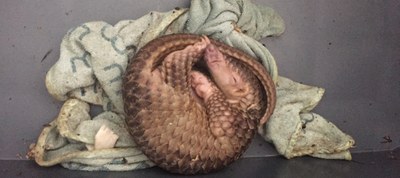Asian Journalists Train to Cover the Illegal Wildlife Trade
Veteran journalism trainers James Fahn, EJN’s Executive Director, and Nantiya Tangwisutijit, EJN’s Mekong Content Coordinator, were hired to lead the workshop and help design the curriculum, working closely with Dararat Weerapong, USAID Wildlife Asia’s Communications, Outreach and Learning Specialist.
Seventeen journalists from Cambodia, China, Indonesia, Laos, Philippines, Thailand and Vietnam joined the workshop, many of them recommended by USAID sister projects around the region. The workshop aimed to empower journalists to do investigative reports and understand wildlife trafficking issues in Southeast Asia, and to create a journalism network to combat wildlife trafficking in target countries.
To meet these goals, workshop organizers arranged a suite of activities that included in-class training sessions, panel discussions of experts providing key insights into the regional wildlife trade, exercise sessions, participation in the 4th Regional Dialogue, and a field trip to Thailand’s Wildlife Quarantine Center in Nakhon Nayok.
The field trip was a great opportunity for the journalists to get some good photos, see the sad conditions that animals are kept in, and learn about the challenges of keeping them in captivity. There was a good deal of discussion about the recent seizure of 186 pangolins in a trafficking bust, and why only 15 remained alive at the center. The veterinarians explained that these creatures and their needs are not yet well understood, and that they usually come in sick, mal-nourished and having suffered terrible conditions in transport. But Vietnamese journalist Pham Hoang Nam said that in talking to Vietnamese officials they had reported a 90% success rate in keeping pangolins alive in captivity.
One of the most intriguing discussions that took place during the field trip came when participants learned that, according to Thai regulations, animals seized from traffickers need to be kept in captivity for at least five years before being released. The reason given for the rule was so that the authorities could have access to evidence for trials (although critics have noted that trials seem few and far between), but other countries in the region don’t seem to require the same rule. They are able to collect and keep evidence through photographs, DNA samples and the like.
Returning seized animals successfully to the wild is always difficult, but requiring them to be kept in captivity for so long makes that almost impossible. Many animals don’t survive long in captivity, and those that do are kept in less than optimal conditions due to a lack of funding.
The final day of the journalism training workshop included country reports from participants in which they described the state of media reporting on wildlife trafficking in each of their countries, and a presentation on media safety by the Southeast Asian Press Alliance. Press freedom is generally in decline in the region, with weak law enforcement to counter violence against media. Perpetrators are often allowed to act with “impunity”. Legal defamation is also a big problem, with reporters sometimes slapped with lawsuits, as recently happened to a reporter at The Nation in Thailand over a mining story. Although that case has now been resolved, many journalists in the region lack the necessary legal support to help fight these spurious cases.
“There is obviously strong interest in and enthusiasm for covering wildlife trafficking from most of the participants, and based on my past interactions, from many other journalists in the region, too. They intuitively understand the importance of the topic, and how emotionally it resonates with their audiences,” said Fahn. “But they do face many obstacles, most notably a lack of time and money to research a story properly. In some cases, they lack expertise, or at least experience, and they also could benefit from better international connections with experts and fellow journalists.”
The journalists came away from the workshop eager to do more, with lots of story ideas and many vowing to work on stories about wildlife trafficking once they returned home. It remains to be seen, however, whether the journalists will have the necessary resources – in terms of time, money and editorial support – to carry them out.
First published by Internews, December 5, 2017


